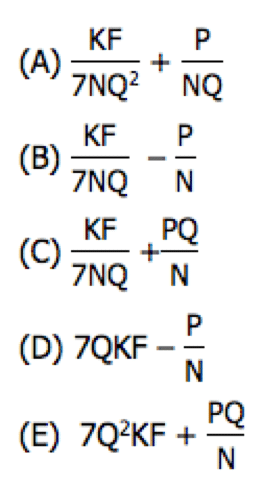
Learn the powerful shortcuts through these problems!
Practice Questions
Before reading this post, try these three related practice questions.
1) Is a positive?
Statement (1): \(a^6\) > a
Statement (2): \(a^5\) > a
2) Is a positive?
Statement (1): \(a^6\) > a
Statement (2): \(a^5\) < a
3) Is a positive?
Statement (1): \(a^6\) < a
Statement (2): \(a^5\) < a
I will give answers and full explanations at the end of this post.
Definitions
When we write \(2^4\), what we are saying is: multiply four factors of 2 together. This results in 16, so we can say \(2^4 = 16\).
In this example, 4 is the exponent; 2 is the base, the number that gets raised to the exponent; 16 is the power, the result of the “raising to an exponent” process; and this process itself is called exponentiation. You can read more about the Laws of Exponents.
One thing that will help you immensely, especially on GMAT Data Sufficiency, are the patterns of raising different kinds of bases to powers.
Simple Patterns
(a) When you raise a base of 1 to any exponent, the power equals 1.
(b) When you raise any base (*) to an exponent of 0, the power equals 1.
(c) When you raise a base of zero to any exponent (*), the power equals 0.
Those two stars indicate an exception in a Zen-like paradoxical case.
If \(a^0 = 1\) for all a, and if \( 0^p = 0\) for all p, then what is \( 0^0\)?
The \(0^0\) case is technically called “indeterminate”, which is a fancy mathematical way of saying: there’s no sensible way to assign any particular value to that expression. You would encounter expressions that approach the value of \(0^0\) in calculus, but on GMAT math, you need not worry about it. We will restate those starred statements as: (b) When you raise any nonzero base to an exponent of 0, the power equals 1; and (c) When you raise a base of zero to any nonzero exponent, the power equals 0.
When we throw in a negative sign, things become a little trickier. A base of –1 to any even integer exponent equals 1. A base of –1 to any odd integer exponent equals –1. What happens when we raise –1 to non-integer powers is also well beyond GMAT math, so you don’t need to worry about that. The odd/even exponent pattern, though, is very important.
In general, a negative base to an even integer exponents results in a positive power. A negative exponent to an odd integer exponents results in a negative power. We will see this played out below, in the four cases.
Case 1: base greater than one
Let look at an example in this category, base = 2.
\(2^0 = 1\)
\(2^1 = 2\)
\(2^2 = 4\)
\(2^3 = 8\)
\(2^4 = 16\)
\(2^{-1} = \frac{1} {2}\)
\(2^{-2} = \frac{1} {4}\)
\(2^{-3} = \frac{1} {8}\)
\(2^{-4} = \frac{1} {16}\)
When we raise a base greater than one to positive integer exponents, the powers just get bigger and bigger (that increase is called “exponential growth”). When we raise a base greater than one to negative integer exponents, the powers are positive fractions less than one that get smaller and smaller, closer and closer to zero as the absolute value of the negative exponent increases.
Case 2: positive base less than one
Let look at an example in this category, base = 1/2.
\(\frac{1} {2}^{-1} = 1\)
\(\frac{1} {2}^1 = \frac{1} {2}\)
\(\frac{1} {2}^2 = \frac{1} {4}\)
\(\frac{1} {2}^3 = \frac{1} {8}\)
\(\frac{1} {2}^4 = \frac{1} {16}\)
\(\frac{1} {2}^{-1} = 2\)
\(\frac{1} {2}^{-2} = 4\)
\(\frac{1} {2}^{-3} = 8\)
\(\frac{1} {2}^{-4} = 16\)
When we raise a positive base less than one to positive integer exponents, the powers are positive fractions less than one that get smaller and smaller, closer and closer to zero as the exponent increases. When we raise a positive base less than one to negative integer exponents, the powers are just bigger and bigger positive numbers, all greater than one.
If the fraction is, like 1/2, the reciprocal of an integer, then negative integer exponents produce positive integer powers, but if the fraction is not the reciprocal of an integer, like 2/3, then negative integer exponents will produce fractions —- 3/2, 9/4, 27/8 — that are all greater than one and increasing in value as the absolute value of the negative exponent increase.
Case 3: negative base less than negative one
In other words, these are negative numbers whose absolute value is greater than one. Let look at an example in this category, base = –2.
\({(-2)}^0 = 1\)
\((-2)^1 = -2\)
\((-2)^2 = 4\)
\((-2)^3 = -8\)
\((-2)^4 = 16\)
\((-2)^{-1} = -\frac{1} {2}\)
\((-2)^{-2} = \frac{1} {4}\)
\((-2)^{-3} = -\frac{1} {8}\)
\((-2)^{-4}= \frac{1} {16}\)
As the exponent increase through positive integers, the absolute value of the powers increases, but as discussed above, the sign flip-flops: positive for even exponents, negative for odd exponents. Each succeeding power is further from zero, but on the opposite side of the number line from the previous power.
As the exponent moves through the negative integers, the absolute value gets smaller, closer and closer to zero, but again, positive for even exponents, negative for odd exponents. Each succeeding power is closer to zero, but on the opposite side of the number line from the previous power. Notice: in this cases, all the negative exponents produce powers that are greater than the original base.
Case 4: negative base between negative one and zero
In other words, these are negative fractions, with an absolute value smaller than one. Let’s look at an example in this category, base = –1/2.
\({-1/2}^0 = 1\)
\((-1/2)^1 = -1/2\)
\((-1/2)^2 = 1/4\)
\((-1/2)^3 = -1/8\)
\((-1/2)^4 = 1/16\)
\((-1/2)^{-1}= -2\)
\((-1/2)^{-2} = 4\)
\((-1/2)^{-3} = -8\)
\((-1/2)^{-4} = 16\)
Now, as the positive integer exponents get larger and larger, the absolute value of the power continually gets smaller, closer and closer to zero, but again, positive for even exponents, negative for odd exponents. NOTICE: every positive integer exponent greater than one produces a power that is greater than the base: that much is true in both Case I and Case IV.
For negative integer exponents, the absolute values increase, getting further and further from zero, and signs flip-flop, positive for even exponents, negative for odd exponents. Even negative exponents product powers greater than the base, and odd negative exponents produce powers less than the base.
Summary
Those four cases involve a lot of detail, and if this is your first time exploring these ideas in a while, just remember the power of plugging in numerical examples to figure out each case. It’s a start to know simply that there are different cases: that alone might lead you to see different choices you can plug in to test, say, a DS question.
If you struggled with those three DS questions at the beginning, this would be an excellent time to revisit them before peeking at the solutions below.
Practice Problem Solutions
I will solve these in terms of the four cases discussed in this blog.
1) Statement #1: This statement is true in Cases I, III, and IV. That’s not enough to determine whether the base a is positive. This statement is insufficient.
Statement #2: This statement is true in Cases I and IV. That’s not enough to determine whether the base a is positive. This statement is insufficient.
Combined: both statements are true of numbers in Case I, and both statements are true of numbers in Case IV. The former are positive, and the later are negative, so we cannot determine the sign of the base. Even combined, these statements are insufficient. Answer = E
2) Statement #1: This statement is true in Cases I, III, and IV. That’s not enough to determine whether the base a is positive. This statement is insufficient.
Statement #2: This statement is true in Cases II and III. That’s not enough to determine whether the base a is positive. This statement is insufficient.
Combined: only numbers is Case III satisfy both of these statements. Combined, it means we must be in Case III, where the bases are negative. Thus, we have a definitive answer to the prompt question. This is sufficient to answer the prompt. Answer = C
3) Statement #1: This statement is true in Cases II only. Numbers is Case II are always positive, so this statement is sufficient to answer the prompt.
Statement #2: This statement is true in Cases II and III. That’s not enough to determine whether the base a is positive. This statement is insufficient.
Answer = A





